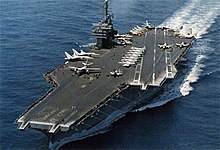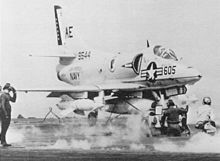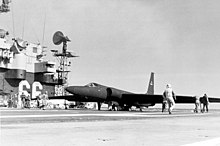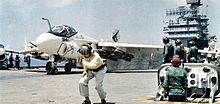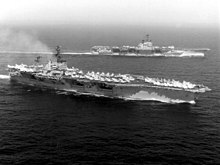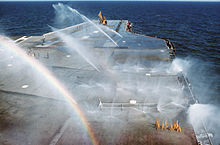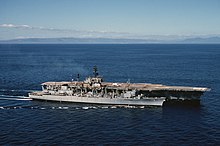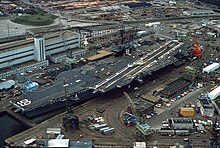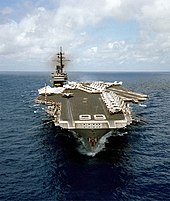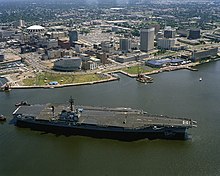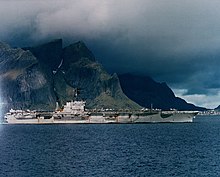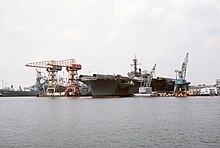USS America (CV-66)
Early in the deployment, from 28 February – 10 March, America participated in a joint Franco-American exercise "Fairgame IV", which simulated conventional warfare against a country attempting to invade a NATO ally.
Shortly after noon on 7 June, Vice Admiral William I. Martin, Commander 6th Fleet sent the following message to the Soviet ship, in Russian and English: Your actions for the past five days have interfered with our operations.
[1] At about 14:00 local time on 8 June 1967, the technical research ship Liberty was attacked by Israeli torpedo boats and jet fighters, about 15 mi (24 km) north of the Sinai port of El Arish, in international waters.
America transited the Dardanelles on 21 June and arrived at Istanbul, where Rear Admiral Geis laid a wreath at the foot of the grave of the Unknown Soldier as a tribute to the Turkish war dead.
The training consisted of invaluable and highly successful exercises in environmental tracking, antimissile defense, airborne jamming against radars, emergency aircraft recovery, and simulated PT boat attacks.
Communications exercises simulated conditions in Gulf of Tonkin, as a high volume of message traffic similar to that to be experienced in southeast Asia was generated by Commander, CarDiv 2, who was embarked in the ship.
On 20 August, at Manila, Vice Admiral Frederic A. Bardshar, Commander, Attack Carrier Striking Force, 7th Fleet, hosted the President of the Philippines, Ferdinand E. Marcos, on board America.
[1] On 2 June 1972, three days before America was to sail Admiral Elmo R. Zumwalt, the Chief of Naval Operations, visited the ship and explained the reason why her orders had been changed sending her to the Gulf of Tonkin instead of the Mediterranean.
[1] On 28 December, the carrier anchored in Hong Kong harbor, and remained there until 4 January 1973, when she stood out for the Philippines and the period of rest and repairs at Subic Bay that would precede the ship's return to the line.
America then steamed south after the Thanksgiving holiday, for Atlantic Fleet readiness exercises, returned via Mayport to Norfolk on 13 December, and remained in her home port until sailing for the Mediterranean on 3 January 1974.
During one phase of this exercise, the carrier's marine detachment embarked in El Paso and stormed ashore from that amphibious ship while America's planes provided close air support.
Immediately following this port call, the ship returned to Athens and sailed thence for exercise "Shahbaz" to test the air defense capability of NATO ally Turkey early in June.
America then anchored off the island of Rhodes, Greece, on 6 June for a four-day port visit, after which time she returned to Athens to embark Naval Academy midshipmen for their summer training cruise.
Making her last port call at Athens for the deployment, the carrier steamed to Souda Bay on 1 July, loading minesweeping equipment that had been used in Operation Nimbus Star, the clearance of the Suez Canal.
While steaming north of Cuba and preparing for the operational readiness inspection that concludes refresher training, America picked up distress calls, immediately deploying helicopters and fixed-wing aircraft to search for a disabled motorized sailboat, Ruggentino.
Following the year-end stand down, the carrier resumed local operations out of Norfolk in January 1976 and, in March participated in exercise "Safe Pass '76" with ships of the Canadian, West German, Dutch and British navies.
The assassination of the United States ambassador to Lebanon Francis E. Meloy, and Economic Counselor Robert O. Waring as they were on their way to visit Lebanese President Elias Sarkis on 16 June 1976 prompted the evacuation of Americans from that nation a week later, on the 20th.
Such practice proved timely, for the following day, A-7 and Grumman F-14 Tomcat aircraft from America intercepted a pair of the long-range "Bear D" planes that were en route to Cuba from their bases in the Soviet Union.
Reaching Palma on 23 April, America then participated in NATO exercise "Daily Double", with the amphibious assault ship Nassau, as well as with Greek and Italian Navy units on the 28th before she steamed to Port Said, Egypt.
[citation needed] On 15 July, America was requested to provide search and rescue (SAR) aircraft to assist in locating a merchant ship in distress in the northern Arabian Sea.
Upon completion of her second northern Arabian Sea line period on 4 August, America shaped a course for Australian waters conducting a "Weapons Week" exercise in the vicinity of Diego Garcia.
As a result of the unsettled conditions in Egypt following 6 October 1981 assassination of President Anwar Sadat, the Egyptian government accorded America's passage through the Suez Canal the utmost security considerations.
America, with CVW-1 embarked, and her accompanying battle group departed Norfolk on 10 March 1986, and arrived in the Mediterranean in time to participate in the third phase of "Attain Document", a freedom of navigation (FON) exercise in the Gulf of Sidra.
82 bombs on the Benghazi military barracks, believed to be an alternate command and control facility for terrorist activities and a billeting area for Qaddafi's elite Jamahiriya Guard, as well as a warehouse for components for MiG aircraft.
On 11 August, Coral Sea and America departed early from separate port visits when they were diverted to the eastern Mediterranean as a show of force in the wake of the suspected hanging of Marine Corps LtCol William R. Higgins by Middle East terrorists, and threats to other hostages.
Strikes of up to five hours into Iraq against bridges, mobile Scud sites, oil production facilities and Iraqi Republican Guard units continued for three weeks, when the focus of the air war changed.
On 9 February Captain Kent W. Ewing took command of the great warship at an informal ceremony on the flight deck and newly selected Rear Admiral Mazach departed under orders to his new assignment.
America and her Joint Task Group departed Norfolk and other east Coast ports on 11 August 1993 for another major Mediterranean deployment to relieve Theodore Roosevelt in Operation Deny Flight.
In a letter to them, then-Vice Chief of Naval Operations Admiral John B. Nathman explained: America will make one final and vital contribution to our national defense, this time as a live-fire test and evaluation platform.
[10] On 16 May 2005, Naval Sea Systems Command released the following statement: On 14 May at approximately 1130 am EDT, a solemn moment of silence was held as the aircraft carrier ex-America slipped quietly beneath the waves.

